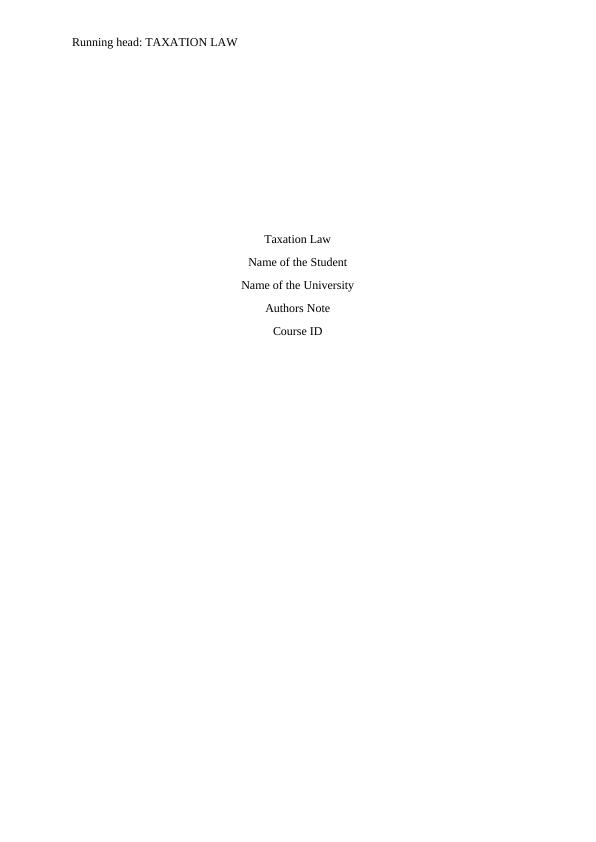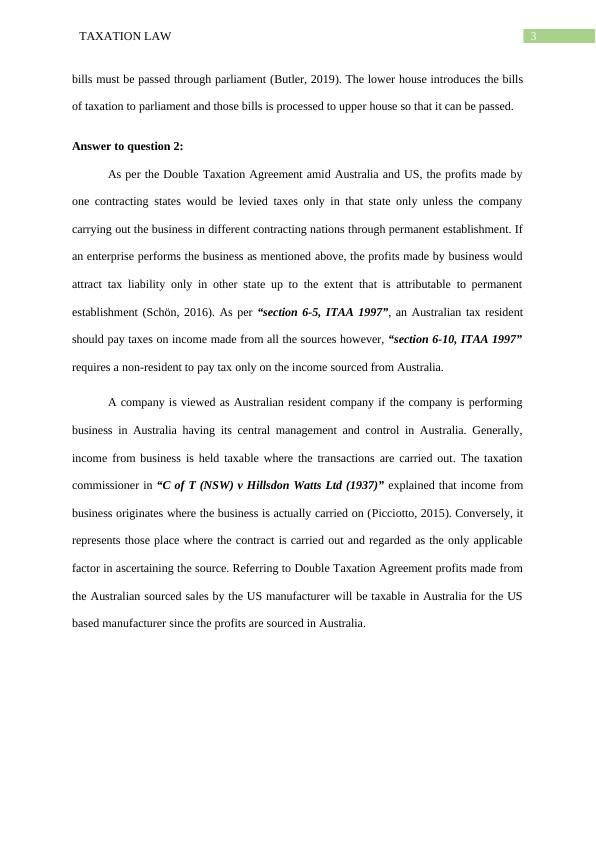Taxation Law
Added on 2023-01-24
12 Pages2912 Words77 Views
Running head: TAXATION LAW
Taxation Law
Name of the Student
Name of the University
Authors Note
Course ID
Taxation Law
Name of the Student
Name of the University
Authors Note
Course ID

1TAXATION LAW
Table of Contents
Answer to question 1:.................................................................................................................2
Answer to A:..........................................................................................................................2
Answer to B:..........................................................................................................................2
Answer to question 2:.................................................................................................................3
Answer to question 3:.................................................................................................................3
Part 1:.....................................................................................................................................3
Answer to A:..........................................................................................................................3
Answer to B:..........................................................................................................................4
Answer to part 2:........................................................................................................................4
Answer to question 4:.................................................................................................................5
Answer to question 5:.................................................................................................................6
Answer to question 6:.................................................................................................................7
Article 1: ATO measures of removing “inequitable” inquiry:...................................................7
Article 1: ATO considers measures for closing gap on multinational Tax Avoidance:........8
Answer to question 7:.................................................................................................................9
References:...............................................................................................................................10
Table of Contents
Answer to question 1:.................................................................................................................2
Answer to A:..........................................................................................................................2
Answer to B:..........................................................................................................................2
Answer to question 2:.................................................................................................................3
Answer to question 3:.................................................................................................................3
Part 1:.....................................................................................................................................3
Answer to A:..........................................................................................................................3
Answer to B:..........................................................................................................................4
Answer to part 2:........................................................................................................................4
Answer to question 4:.................................................................................................................5
Answer to question 5:.................................................................................................................6
Answer to question 6:.................................................................................................................7
Article 1: ATO measures of removing “inequitable” inquiry:...................................................7
Article 1: ATO considers measures for closing gap on multinational Tax Avoidance:........8
Answer to question 7:.................................................................................................................9
References:...............................................................................................................................10

2TAXATION LAW
Answer to question 1:
Answer to A:
Australian is viewed as the federation and its legislative power is widespread between
the commonwealth and states. Referring to “Section 51 (ii)” the commonwealth power are
given under this section. This “Section 51 (ii)” provides commonwealth with the permission
of making laws in respect to tax but does not requires making discrimination among the states
or any parts of states (Miller & Oats, 2016). The commonwealth board has the power of
imposing tax which must be considered as substance to the commencement of “Section 51”
that explains the right of making power and are subject to constitutions. The exclusive power
of applying tax on customs and excise duties by Commonwealth is given under “section 90”.
Answer to B:
The progress of tax policy rests with Australian government and the treasury minister
is responsible for its application. The Australian taxation office plays the vital role in the
formation of tax policy and legislation process that reflects the interdependence of laws,
policy and managerial aspects of tax system (Gamage & Livingston, 2018). The primary role
of ATO is to administer tax and laws relating to superannuation which the parliament passes.
To execute this, the administrative arrangement of applying taxation law is developed by the
ATO which also includes educating and advising the taxpayers relating to their duties and
rights.
The High Court of Australia plays an important role of interpreting and applying the
tax in Australia to determine the cases that have specific federal significances along with
challenges of constitutional validity of law and hearing the appeals of territory courts, federal
and state courts. The parliament consists of lower and upper houses and the parliamentary
Answer to question 1:
Answer to A:
Australian is viewed as the federation and its legislative power is widespread between
the commonwealth and states. Referring to “Section 51 (ii)” the commonwealth power are
given under this section. This “Section 51 (ii)” provides commonwealth with the permission
of making laws in respect to tax but does not requires making discrimination among the states
or any parts of states (Miller & Oats, 2016). The commonwealth board has the power of
imposing tax which must be considered as substance to the commencement of “Section 51”
that explains the right of making power and are subject to constitutions. The exclusive power
of applying tax on customs and excise duties by Commonwealth is given under “section 90”.
Answer to B:
The progress of tax policy rests with Australian government and the treasury minister
is responsible for its application. The Australian taxation office plays the vital role in the
formation of tax policy and legislation process that reflects the interdependence of laws,
policy and managerial aspects of tax system (Gamage & Livingston, 2018). The primary role
of ATO is to administer tax and laws relating to superannuation which the parliament passes.
To execute this, the administrative arrangement of applying taxation law is developed by the
ATO which also includes educating and advising the taxpayers relating to their duties and
rights.
The High Court of Australia plays an important role of interpreting and applying the
tax in Australia to determine the cases that have specific federal significances along with
challenges of constitutional validity of law and hearing the appeals of territory courts, federal
and state courts. The parliament consists of lower and upper houses and the parliamentary

3TAXATION LAW
bills must be passed through parliament (Butler, 2019). The lower house introduces the bills
of taxation to parliament and those bills is processed to upper house so that it can be passed.
Answer to question 2:
As per the Double Taxation Agreement amid Australia and US, the profits made by
one contracting states would be levied taxes only in that state only unless the company
carrying out the business in different contracting nations through permanent establishment. If
an enterprise performs the business as mentioned above, the profits made by business would
attract tax liability only in other state up to the extent that is attributable to permanent
establishment (Schön, 2016). As per “section 6-5, ITAA 1997”, an Australian tax resident
should pay taxes on income made from all the sources however, “section 6-10, ITAA 1997”
requires a non-resident to pay tax only on the income sourced from Australia.
A company is viewed as Australian resident company if the company is performing
business in Australia having its central management and control in Australia. Generally,
income from business is held taxable where the transactions are carried out. The taxation
commissioner in “C of T (NSW) v Hillsdon Watts Ltd (1937)” explained that income from
business originates where the business is actually carried on (Picciotto, 2015). Conversely, it
represents those place where the contract is carried out and regarded as the only applicable
factor in ascertaining the source. Referring to Double Taxation Agreement profits made from
the Australian sourced sales by the US manufacturer will be taxable in Australia for the US
based manufacturer since the profits are sourced in Australia.
bills must be passed through parliament (Butler, 2019). The lower house introduces the bills
of taxation to parliament and those bills is processed to upper house so that it can be passed.
Answer to question 2:
As per the Double Taxation Agreement amid Australia and US, the profits made by
one contracting states would be levied taxes only in that state only unless the company
carrying out the business in different contracting nations through permanent establishment. If
an enterprise performs the business as mentioned above, the profits made by business would
attract tax liability only in other state up to the extent that is attributable to permanent
establishment (Schön, 2016). As per “section 6-5, ITAA 1997”, an Australian tax resident
should pay taxes on income made from all the sources however, “section 6-10, ITAA 1997”
requires a non-resident to pay tax only on the income sourced from Australia.
A company is viewed as Australian resident company if the company is performing
business in Australia having its central management and control in Australia. Generally,
income from business is held taxable where the transactions are carried out. The taxation
commissioner in “C of T (NSW) v Hillsdon Watts Ltd (1937)” explained that income from
business originates where the business is actually carried on (Picciotto, 2015). Conversely, it
represents those place where the contract is carried out and regarded as the only applicable
factor in ascertaining the source. Referring to Double Taxation Agreement profits made from
the Australian sourced sales by the US manufacturer will be taxable in Australia for the US
based manufacturer since the profits are sourced in Australia.

End of preview
Want to access all the pages? Upload your documents or become a member.
Related Documents
Taxation Lawlg...
|12
|3033
|55
Taxation Lawlg...
|12
|2985
|62
Taxation Lawlg...
|12
|2825
|55
Taxation Lawlg...
|12
|2952
|67
Taxation Lawlg...
|12
|2884
|1
Australian Taxation Law- Assignmentlg...
|11
|3079
|459
